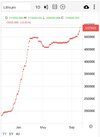JohnDe
La dolce vita
- Joined
- 11 March 2020
- Posts
- 4,335
- Reactions
- 6,397
Maybe that was intentional
"Lithium stocks suffered an astonishing selldown after major investment bank Goldman Sachs called the top of the battery metals boom in a note last week."
The problem with lithium shares is that there is lithium everywhere.







